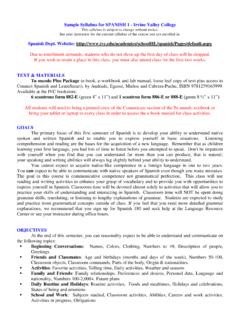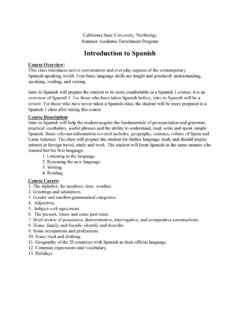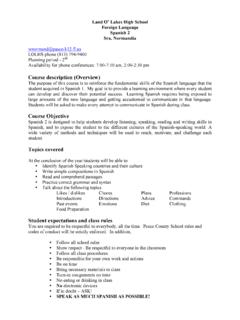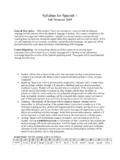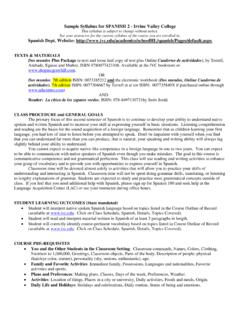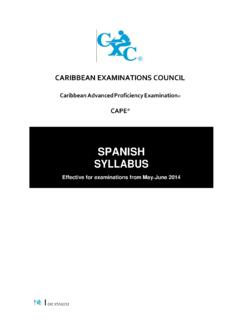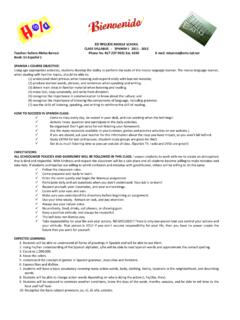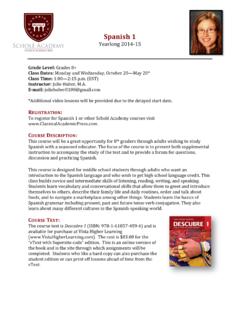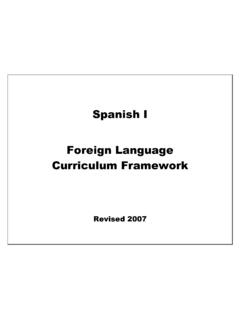Transcription of Spanish 1 - The Ogburn School
1 Spanish 1 1 Lesson 1: Basic Needs Directions: You will use the worktext throughout the course. Pay special attention to which pages you need for each assignment. Daily word: Visit this link for the Daily Word. Even though you are just beginning to learn Spanish , adding to your vocabulary by reading and hearing new words is a good learning strategy. or There are many internet sites that provide Spanish language resources. Seek them out! Part 1: Worktext pg. 70. Learn the alphabet before learning words and phrases. Visit the following link to practice pronunciation of the alphabet. Click on each letter to hear the correct pronunciation. Scroll down the page, click on each letter to practice the pronunciation of letters. Click on each of the topics links to learn more about vowels, intonation, consonants, and diphthongs that comprise the Spanish language. You will find it similar to English in many ways. Spanish 1 2 Part 2: Worktext pg. 3-4. a. Column 1: Read the ?/Ans/Link (Question, Answer, Link) This column provides a basic question word (?)
2 , and answer word (Ans), and a linking (Link) word. Practice reading, writing and speaking these words over and over. Practice makes perfect. (You will see this phrase over and over in the course!) b. Column 2: Read the Group 1 words. Practice reading, writing and speaking these words over and over. Practice makes perfect. c. Column 3: Read the Group 2 words. Practice reading, writing and speaking these words over and over. Practice makes perfect. d. Column 4: Read the Group 3 words. Practice reading, writing and speaking these words over and over. Practice makes perfect. Do you see how these words and phrases can be mixed and matched to create meaningful sentences? Practice putting together these words and phrases. Write down as many phrases as you can. Practice reading and speaking these words over and over. Practice makes perfect. How many phrases did you create? Place your phrases in your portfolio. Don t forget to label the lessons. Part 3: Worktext pp. 30-36. Complete the exercises in the Basic Needs section.
3 You may write directly in the worktext. Spanish 1 3 Lesson 1 Review: Progress notes In your portfolio, explain how the alphabet forms words words form phrases - phrases form sentences. How many phrases did you create? How did the web link help you with these words and phrases? Have you completed Exercises 1-12, pp 30-36 in the worktext? Are you up-to-date with your portfolio? Move on to Lesson Spanish 1 4 Lesson 2: Greetings Don t forget the Daily Word: or Directions: Beginning with this lesson, you will see directions and notes in English and Spanish . Are you not sure? Use Google translator. It s free and it s fun. Just type in Google translator in the Google search bar, and there it is. It s a it! This lesson introduces basic greetings, or saludos. Visit the following link to listen and practice greetings. Esta lecci n presenta a los saludos, o saludos. Visita el siguiente enlace para escuchar y practicar saludos. Click on the topic, Meeting People to practice common phrases.
4 Click on the individual links (Words 1, Words 2, etc.) to hear the pronunciation. Take the quiz and test. Record your scores in your portfolio. Spanish 1 5 Part 1: Worktext pg. 5, Greetings Practice reading and speaking the comments and responses. Practice until you are comfortable with the phrases and do not need to refer to the book. Practicar la lectura y diciendo que los comentarios y respuestas. Practica hasta que se sienta c modo con las frases y no es necesario hacer referencia al libro. Part 2: Worktext pg. 37-38. Complete the exercises in the Greetings section. You may write directly in the book. Part 3: Worktext pp. 72-73. Practice the Spanish consonants II and by reading the speaking the sample words and sample sentences. Practique las consonantes espa olas "II" y "N" mediante la lectura de la frase las palabras y frases de muestra de la muestra. Lesson 2 Review: Progress notes In your portfolio, explain how the Spanish consonants differ from English consonants?
5 Have you completed the exercises in the worktext? Did you practice the pronunciation of the Spanish consonants II and ? Are you up-to-date with your portfolio? Move on to Lesson Spanish 1 6 Lesson 3: Survival Expressions Don t forget the Daily Word: or Directions: Survival expressions are those basic phrases that will help you if you are in a Spanish speaking region. Visit this link to listen and practice survival expressions. Expresiones de supervivencia son aquellas frases b sicas que le ayudar n si usted est en una regi n de habla espa ola. Visite este enlace para escuchar y practicar las expresiones de supervivencia. Visit this link for helpful examples of survival phrases. Start with the Airport Topic. Then go through the remaining topics one at a time. Take the quiz and the test for each topic. Record your scores in your portfolio. Spanish 1 7 Part 1: Worktext pg 6. Read and practice these Survival Expressions. Write these expressions in your portfolio.
6 Leer y practicar estas expresiones de supervivencia. Escribir estas expresiones en su cartera. Part 2: Worktext pg. 39 Complete the exercises in the Survival Expressions section. You may write directly in the book. Part 3: Worktext pg. 73. Practice the Spanish consonant z by reading and practicing the sound differences, sample words, and sample sentences. Practicar el espa ol consonante "z" por la lectura y la pr ctica de las diferencias de sonido, palabras y oraciones de ejemplo de la muestra. Review the pronunciation by visiting this link again. Lesson 3 Review: Progress notes In your portfolio, explain how survival expressions are helpful if you are in a Spanish speaking region. Have you completed the exercises in the worktext? Did you practice the pronunciation of the Spanish consonant Z ? How does the Spanish consonant Z differ from the English consonant Z ? Are you up-to-date with your portfolio? Move on to Lesson Spanish 1 8 Lesson 4: Grammar Don t forget the Daily Word: or Directions: Grammar is a fundamental skill that helps to understand the format of a language.
7 Learn these basic rules. La gram tica es una habilidad fundamental que ayuda a entender el formato de una lengua. Aprenda las reglas b sicas. Visit the following link to learn and hear more about basic grammar rules. Read the Gender of Nouns I Lesson, and then complete the Basic Quiz and the Mini-Test. To hear pronunciation click on the Oral I link in the left sidebar. On the left sidebar, scroll down to Unit Two. Repeat the same instructions for the Unit II: Gender of Nouns II - Lessons #15 and #16. Unit Two - # 15, Ser and Estar I (Read the lesson, and then complete the Basic Quiz and the Mini-Test) Unit Two - #16, Ser and Estar II (Read the lesson, and then complete the Basic Quiz and the Mini-Test) Record your scores in your portfolio. Spanish 1 9 Part 1: Worktext pg. 7 Read this information on Grammar. Study the chart. Learn the rules. Lea esta informaci n en la gram tica. Estudia la tabla. Aprende las reglas. Visit these links for more information on Spanish grammar.
8 Note: This is a children s site but the verb conjugator and other games are fun anyway. #Articles Note: This is scholarly and lengthy, but you might find just what you need! Part 2: Worktext pg. 40-41 Complete the exercises in the Grammar section. You may write directly in the book. Leer y practicar estas expresiones gramaticales. Escribir estas expresiones en su cartera. Part 3: Worktext pp. 74-75 Practice the Spanish consonant d by reading and practicing the sound differences, sample words, and sample sentences. When is the d hard? When is the d soft? Practicar el espa ol consonante "d" por la lectura y la pr ctica de las diferencias de sonido, palabras y oraciones de ejemplo de la muestra. Cu ndo es la "d" duro? Cu ndo es la "d" suave? Review the d pronunciation by visiting this link again. Spanish 1 10 Lesson 4 Review: Progress notes In your portfolio, explain how grammar is important to understanding a language. Have you completed the exercises in the worktext?
9 Did you practice the pronunciation of the Spanish consonant d with both hard and soft sounds? Are you up-to-date with your portfolio? Move on to Lesson Spanish 1 11 Lesson 5: Comprehending Native Speakers Don t forget the Daily Word: or Directions: Native speakers are generally friendly and eager to help you understand their language. The quickest way to learn something new is to work with someone. This lesson provides helpful phrases that will help you communicate with a native speaker. Los nativos son por lo general amables y dispuestos a ayudarle a entender su lenguaje. La forma m s r pida de aprender algo nuevo es trabajar con alguien. Esta lecci n ofrece frases tiles que le ayudar n a comunicarse con un hablante nativo. Visit this link to add to your vocabulary, which will help you communicate with native speakers, too. Click on any of the Cultural Notes topics. Many of the topics have an audio option. Follow the instructions on screen for instructions and helpful tips.
10 Spanish 1 12 Part 1: Worktext pg. 8 Read this information on Comprehending Native Speakers. Substitute some words in the phrases for practice. Lea esta informaci n en la comprensi n de los hablantes nativos. Esta p gina contiene frases tiles que le ayudar n a comunicarse con un hablante nativo. Sustituir unas palabras en las frases para la pr ctica. Part 2: Worktext pg. 42 Complete the exercises in the Comprehending Native Speakers section. You may write directly in the book. Complete estos ejercicios para los oradores nativos Comprenda usted puede escribir directamente en el libro. Part 3: Worktext pg. 76 Practice the Spanish consonant trilled rr or r by reading and practicing the sound differences, sample words, and sample sentences. Also note the rr substitute. Practica la consonante espa ola "gorjeo rr" o "r" por la lectura y la pr ctica de las diferencias de sonido, palabras y oraciones de ejemplo de la muestra. Tambi n tenga en cuenta la "rr" sustituto. Revisit this link to continue learning and practicing the alphabet and correct pronunciations.



